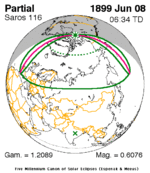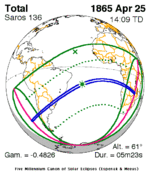A total solar eclipse occurred on May 18, 1901.[1][2][3][4] A solar eclipse occurs when the Moon passes between Earth and the Sun, thereby totally or partly obscuring the image of the Sun for a viewer on Earth. A total solar eclipse occurs when the Moon's apparent diameter is larger than the Sun's, blocking all direct sunlight, turning day into darkness. Totality occurs in a narrow path across Earth's surface, with the partial solar eclipse visible over a surrounding region thousands of kilometres wide. The path of totality crossed French Madagascar (the part now belonging to Madagascar), Réunion, British Mauritius (now Mauritius), Dutch East Indies (now Indonesia), and British New Guinea (now belonging to Papua New Guinea).
YouTube Encyclopedic
-
1/5Views:34 37136 3702 217 4675 459 87645 473
-
Eclipses That Aligned with Important Events in History
-
America’s Coast-to-Coast Total Solar Eclipse
-
Donald Trump Family Tree
-
Comparison: Oldest History Videos Taken
-
Gerhana Matahari Padang 1901 | HISTORIA.ID
Transcription
Related eclipses
Solar eclipses 1901–1902
This eclipse is a member of the 1898–1902 solar eclipse semester series. An eclipse in a semester series of solar eclipses repeats approximately every 177 days and 4 hours (a semester) at alternating nodes of the Moon's orbit.
| Solar eclipse series sets from 1898 to 1902 | ||||
|---|---|---|---|---|
| Ascending node | Descending node | |||
| 111 | December 13, 1898 Partial |
116 | June 8, 1899 Partial | |
| 121 | December 3, 1899 Annular |
126 | May 28, 1900 Total | |
| 131 | November 22, 1900 Annular |
136 | May 18, 1901 Total | |
| 141 | November 11, 1901 Annular |
146 | May 7, 1902 Partial | |
| 151 | October 31, 1902 Partial | |||
Saros 136
Solar Saros 136, repeating every 18 years, 11 days, contains 71 events. The series started with partial solar eclipse on June 14, 1360, and reached a first annular eclipse on September 8, 1504. It was a hybrid event from November 22, 1612, through January 17, 1703, and total eclipses from January 27, 1721, through May 13, 2496. The series ends at member 71 as a partial eclipse on July 30, 2622, with the entire series lasting 1262 years. The longest eclipse occurred on June 20, 1955, with a maximum duration of totality at 7 minutes, 7.74 seconds. All eclipses in this series occurs at the Moon's descending node.[5]
| Series members 29–43 occur between 1865 and 2117 | ||
|---|---|---|
| 29 | 30 | 31 |
 Apr 25, 1865 |
 May 6, 1883 |
 May 18, 1901 |
| 32 | 33 | 34 |
 May 29, 1919 |
 Jun 8, 1937 |
 Jun 20, 1955 |
| 35 | 36 | 37 |
 Jun 30, 1973 |
 Jul 11, 1991 |
 Jul 22, 2009 |
| 38 | 39 | 40 |
 Aug 2, 2027 |
 Aug 12, 2045 |
 Aug 24, 2063 |
| 41 | 42 | 43 |
 Sep 3, 2081 |
 Sep 14, 2099 |
 Sep 26, 2117 |
Inex series
This eclipse is a part of the long period inex cycle, repeating at alternating nodes, every 358 synodic months (≈ 10,571.95 days, or 29 years minus 20 days). Their appearance and longitude are irregular due to a lack of synchronization with the anomalistic month (period of perigee). However, groupings of 3 inex cycles (≈ 87 years minus 2 months) comes close (≈ 1,151.02 anomalistic months), so eclipses are similar in these groupings.
| Inex series members between 1901 and 2100: | ||
|---|---|---|
 May 18, 1901 (Saros 136) |
 April 28, 1930 (Saros 137) |
 April 8, 1959 (Saros 138) |
 March 18, 1988 (Saros 139) |
 February 26, 2017 (Saros 140) |
 February 5, 2046 (Saros 141) |
 January 16, 2075 (Saros 142) |
||
Notes
- ^ "Viewing the solar eclipse: Many of America's astronomers now on the other side of the globe". The Atchison Daily Globe. Atchison, Kansas. 1901-05-17. p. 7. Retrieved 2023-10-27 – via Newspapers.com.
- ^ "The sun eclipsed: On the whole astronomers have been disappointed". The Fresno Morning Republican. Fresno, California. 1901-05-19. p. 8. Retrieved 2023-10-27 – via Newspapers.com.
- ^ "The Eclipse of the Sun". Daily News Advertiser. Vancouver, British Columbia, Canada. 1901-05-19. p. 4. Retrieved 2023-10-27 – via Newspapers.com.
- ^ "What is the solar corona?". San Francisco Chronicle. San Francisco, California. 1901-11-10. p. 6. Retrieved 2023-10-27 – via Newspapers.com.
- ^ SEsaros136 at NASA.gov
References
- Earth visibility chart and eclipse statistics Eclipse Predictions by Fred Espenak, NASA/GSFC
- Photo of Solar Corona May 18, 1901
- Eclipse of May 18, 1901 (Sumatra). Contact print from the original glass plate negative. Lick Observatory Plate Archive, Mt. Hamilton.
- Total Eclipse of the Sun, May 18, 1901 Reports on the Dutch Expedition to Karang Sago, Sumatra, by Dr. A. A. Nijland, March 1903, Utrecht, Published by the Eclipse Committee of the Royal Academy, Amsterdam
- Russia expedition for solar eclipse of May 18, 1901




